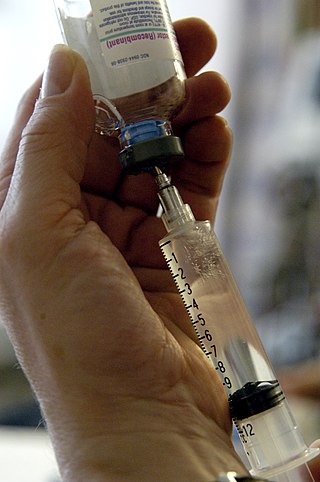Related Research Articles
Erectile dysfunction (ED), also referred to as impotence, is a form of sexual dysfunction in males characterized by the persistent or recurring inability to achieve or maintain a penile erection with sufficient rigidity and duration for satisfactory sexual activity. It is the most common sexual problem in males and can cause psychological distress due to its impact on self-image and sexual relationships. Majority of ED cases are attributed to physical risk factors and predictive factors. These factors can be categorized as vascular, neurological, local penile, hormonal, and drug-induced. Notable predictors of ED include aging, cardiovascular disease, diabetes mellitus, high blood pressure, obesity, abnormal lipid levels in the blood, hypogonadism, smoking, depression, and medication use. Approximately 10% of cases are linked to psychosocial factors, encompassing conditions like depression, stress, and problems within relationships.

Priapism is a condition in which a penis remains erect for hours in the absence of stimulation or after stimulation has ended. There are three types: ischemic (low-flow), nonischemic (high-flow), and recurrent ischemic (intermittent). Most cases are ischemic. Ischemic priapism is generally painful while nonischemic priapism is not. In ischemic priapism, most of the penis is hard; however, the glans penis is not. In nonischemic priapism, the entire penis is only somewhat hard. Very rarely, clitoral priapism occurs in women.

Penis enlargement, or male enhancement, is any technique aimed to increase the size of a human penis. Some methods aim to increase total length, others the shaft's girth, and yet others the glans size. Techniques include surgery, supplements, ointments, patches, and physical methods like pumping, jelqing, and traction.
Sexual dysfunction is difficulty experienced by an individual or partners during any stage of normal sexual activity, including physical pleasure, desire, preference, arousal, or orgasm. The World Health Organization defines sexual dysfunction as a "person's inability to participate in a sexual relationship as they would wish". This definition is broad and is subject to many interpretations. A diagnosis of sexual dysfunction under the DSM-5 requires a person to feel extreme distress and interpersonal strain for a minimum of six months. Sexual dysfunction can have a profound impact on an individual's perceived quality of sexual life. The term sexual disorder may not only refer to physical sexual dysfunction, but to paraphilias as well; this is sometimes termed disorder of sexual preference.

An injection is the act of administering a liquid, especially a drug, into a person's body using a needle and a syringe. An injection is considered a form of parenteral drug administration; it does not involve absorption in the digestive tract. This allows the medication to be absorbed more rapidly and avoid the first pass effect. There are many types of injection, which are generally named after the body tissue the injection is administered into. This includes common injections such as subcutaneous, intramuscular, and intravenous injections, as well as less common injections such as intraperitoneal, intraosseous, intracardiac, intraarticular, and intracavernous injections.

Papaverine is an opium alkaloid antispasmodic drug, used primarily in the treatment of visceral spasms and vasospasms, occasionally in the treatment of erectile dysfunction and acute mesenteric ischemia. While it is found in the opium poppy, papaverine differs in both structure and pharmacological action from the analgesic morphine and its derivatives.

Phentolamine, sold under the brand name Regitine among others, is a reversible nonselective α-adrenergic antagonist.

Prostaglandin E1 (PGE1), also known as alprostadil, is a naturally occurring prostaglandin which is used as a medication. In infants with congenital heart defects, it is delivered by slow injection into a vein to open the ductus arteriosus until surgery can be carried out. By injection into the penis or placement in the urethra, it is used to treat erectile dysfunction.
Venous leak, also called venogenic erectile dysfunction and penile venous insufficiency, is one category of vasculogenic impotence — a cause of erectile dysfunction in males. It affects all ages, being particularly awkward in young men. Much about venous leaks has not reached a consensus among the medical community, and many aspects of the condition, particularly its treatment strategies, are controversial. The prevalence of the condition is still unknown, although some sources claim it to be a common cause of erectile dysfunction.
Clitoral enlargement methods are forms of body modification that have the potential to increase the size of the clitoris and enhance sexual pleasure. Clitoral enlargement can be accomplished through a variety of means, each potentially having certain side effects and risks.

A penile implant is an implanted device intended for the treatment of erectile dysfunction, Peyronie's disease, ischemic priapism, deformity and any traumatic injury of the penis, and for phalloplasty or metoidioplasty, including in gender-affirming surgery. Men also opt for penile implants for aesthetic purposes. Men's satisfaction and sexual function is influenced by discomfort over genital size which leads to seek surgical and non-surgical solutions for penis alteration. Although there are many distinct types of implants, most fall into one of two categories: malleable and inflatable transplants.

Avanafil is a PDE5 inhibitor approved for erectile dysfunction by the FDA on April 27, 2012 and by EMA on June 21, 2013. Avanafil is sold under the brand names Stendra and Spedra. It was invented at Mitsubishi Tanabe Pharma, formerly known as Tanabe Seiyaku Co., and licensed to Vivus Inc., which partnered with Menarini Group to commercialise Spedra in over forty European countries, Australia, and New Zealand. Metuchen Pharmaceuticals obtained exclusive rights within the United States.

Alpha-blockers, also known as α-blockers or α-adrenoreceptor antagonists, are a class of pharmacological agents that act as antagonists on α-adrenergic receptors (α-adrenoceptors).
Boston Medical Group is a network of medical offices sharing research information and treatment methods for erectile dysfunction and premature ejaculation.
An intracavernousinjection is an injection into the base of the penis. This injection site is often used to administer medications to check for or treat erectile dysfunction in adult men. The more common medications administered in this manner include Caverject, Trimix, Bimix, and Quadmix. These medications are all types of vasodilators and cause tumescence within 10-15 minutes. Common side effects include priapism, bruising, fibrosis, Peyronie's disease, and pain.

Clitoral erection is a physiological phenomenon where the clitoris becomes enlarged and firm.
Combined intracavernous injection and stimulation test or CIS test is the most commonly performed office diagnostic procedure for erectile dysfunction. It consists of an intracavernosal injection, visual or manual sexual stimulation, and a rating of the subsequent erection. Neurogenic and hormonal influences are thus bypassed as the status of the blood vessels of the penis is assessed directly and objectively. A rigid erection of more than 10 minutes indicates normal function of veins. The same conclusion cannot be made for the function of arteries as some men with mild arterial problems can also have the same response.

Ronald Virag is a French cardiovascular surgeon who specialises in andrology, the study of the male reproductive system. After training in general and cardiovascular surgery at Paris University, he shifted his focus to the study of erectile dysfunction, which has been his primary area of study since 1978. In 1981, he founded a private institute in France dedicated to the clinical study of erectile dysfunction and developed early programs using intracavernosal drugs to treat the condition.
Penile implants may be employed to treat erectile dysfunction or urinary troubles after a spinal cord injury.

Glans insufficiency syndrome, also known as the soft glans, cold glans, or glans insufficiency, is a medical condition that affects male individuals. This condition is characterized by the persistent inability of the glans penis to achieve and maintain an erect or turgid state during sexual arousal, remaining soft and cold. This condition can have an impact on a person's sexual function, including decreased sensitivity, difficulty in maintaining an erection, and overall quality of life.
References
- 1 2 3 Elena BW, Zachary M, Haritha P, Graham BA, Hellstorm J (April 2023). "Current status of intracavernosal injection therapy in erectile dysfunction". Expert Opinion on Pharmacotherapy . 24 (8): 925–933. doi:10.1080/14656566.2023.2204189. PMID 37078428. S2CID 258238107.
- 1 2 3 Marmar JL, Harkins TJ, Riordan J (May 2008). "Studies with Trimix gel in men who failed phosphodiesterase inhibitors". Journal of Urology . 179 (4S): 431. doi:10.1016/s0022-5347(08)61264-1. ISSN 0022-5347.
- 1 2 3 4 5 6 7 Duncan C, Omran GJ, Teh J, Davis NF, Bolton DM, Lawrentschuk N (June 2019). "Erectile dysfunction: a global review of intracavernosal injectables". World Journal of Urology . 37 (6): 1007–1014. doi:10.1007/s00345-019-02727-5. PMID 30895359. S2CID 84185652.
- ↑ Seyam R, Mohamed K, Akhras AA, Rashwan H (2005). "A prospective randomized study to optimize the dosage of trimix ingredients and compare its efficacy and safety with prostaglandin E1". International Journal of Impotence Research. 17 (4): 346–53. doi: 10.1038/sj.ijir.3901313 . PMID 15772683.
- ↑ Kim SC, Chang IH, Jeon HJ (August 2003). "Preference for oral sildenafil or intracavernosal injection in patients with erectile dysfunction already using intracavernosal injection for > 1 year". BJU International. 92 (3): 277–80. doi:10.1046/j.1464-410X.2003.04324.x. PMID 12887483. S2CID 41078747.
- ↑ Israilov S, Baniel J, Shmueli J, Niv E, Engelstein D, Segenreich E, Livne PM (March 2004). "Treatment program for erectile dysfunction in patients with cardiovascular diseases". The American Journal of Cardiology. 93 (6): 689–93. doi:10.1016/j.amjcard.2003.11.049. PMID 15019870.
- ↑ Jain, Ashish; Iqbal, Omar (18 July 2022). "Alprostadil". StatPearls Publishing. PMID 31194374 . Retrieved 24 April 2023.
- ↑ Kim ED, el-Rashidy R, McVary KT (February 1995). "Papaverine topical gel for treatment of erectile dysfunction". The Journal of Urology . 153 (2): 361–5. doi:10.1097/00005392-199502000-00019. PMID 7815584.
- ↑ Bella AJ, Brock GB (2004). "Intracavernous pharmacotherapy for erectile dysfunction". Endocrine . 23 (2–3): 149–55. doi:10.1385/ENDO:23:2-3:149. PMID 15146094. S2CID 13056029.
The vasoactive potential of phentolamine was discovered in 1978, with early animal studies suggesting effective blockade of the epinephrine pressor response and a smaller sympatholytic effect (63). An alpha-adrenergic antagonist with equal affinity for α1 and α2 receptors, monotherapy with phentolamine has been disappointing. It is hypothesized that although intracavernous injection of phentolamine increases corporal blood flow, a concurrent increase in norepinephrine prevent sinusoidal relaxation.
- ↑ Billingsley, Alyssa (28 January 2022). "What to Know About Trimix Injections for Erectile Dysfunction". GoodRx Health. Retrieved 26 April 2023.
- ↑ "Alprostadil / Papaverine / Phentolamine 20mcg-30mg-1mg/ml Injection Solution (Tri-Mix) | Formulas | My Dashboard | Bayview Pharmacy". www.bayviewrx.com. Retrieved 2023-01-11.
- ↑ Trissel LA, Zhang Y (2004). "Long-term stability of trimix: a three-drug injection used to treat erectile dysfunction". International Journal of Pharmaceutical Compounding. 8 (3): 231–5. PMID 23924676.